Ikkyo Complete 4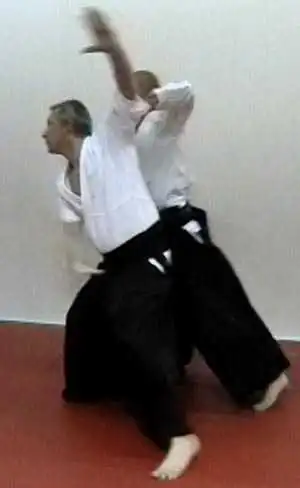 Ushiro — Attacks from behindUshiro RelationThe ushiro relation is when the attacker comes from behind, or goes to the rear of the defender. Normally, you would try to avoid that, by turning toward the attacker, but that is not always possible to begin with, nor is it in aikido that necessary — because of the general principle of the taisabaki evasive steps. Actually, because of the aikido joining of forces and directions, having the attacker behind you can sometimes be more practical than when facing you.
Ushiro relation
Ikkyo and other aikido techniques against ushiro attacks. Many more aikido videos on my YouTube Channel.
The attacker wants to stand out of reach of the defender's free hand. That is behind the defender, at the side of the arm grabbed. If you don't ever practice morotedori this way, you will find that many of your techniques don't work, when it is applied. It is quite different from a grip at your front. There are many ways to begin the ikkyo from this position. For example, you can take a step forward and turn to the side, thereby pulling the attacker with you and out of balance, and then swiftly turn back toward him or her for the ikkyo. In this video clip, however, I show another solution, which is sort of my favorite. I take a step to the other side of the attacker, and after that I spin around toward him or her. I guess you have to see the video clip, to understand what I mean. You apply the ikkyo by turning the attacker's arm around vertically, a bit like turning the steering wheel of a car. It is quite easy — even on a strong grip — if you start the movement by lowering your elbow, and not at all by trying to push the attacker's arm upward. When you lower your elbow, the attacker's outer arm will automatically go up — in particular its elbow, which is the important thing, to get control of his or her arm. The rest of the ikkyo is pretty normal.
Ushiro ryotedori — omote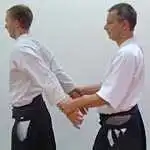 Ushiro ryotedori is a classical ushiro attack form. When dealt with in jutai, a timing where you move before the attack is complete, it is easy enough to handle. In gotai, where you allow the attacker to grip both your wrists firmly, it can be a bit more tricky — especially if the attacker is strong and has a solid stand. Below, I show both forms, but let's begin with gotai.
Ushiro ryotedori is a classical ushiro attack form. When dealt with in jutai, a timing where you move before the attack is complete, it is easy enough to handle. In gotai, where you allow the attacker to grip both your wrists firmly, it can be a bit more tricky — especially if the attacker is strong and has a solid stand. Below, I show both forms, but let's begin with gotai.When the grip is very firm, you have to twist your body to get one of your hands in front of you. One could say that you use your hip, but I don't like that way of relating to it. Better to say that you use your center. You turn sideways, pushing your hip in between your hands. Now, if you just let one of your hands rest on your hip, you can bring it with you when you turn your hip back. Let your fingers point forward and keep your elbow close to your body, so that you get under the attacker's arm, and not get stuck above it. With the angle of your hand, you can make the attacker's elbow move up and outward. Make sure that your hand points the way, in the circular movement you use to get the attacker's arm over your head and in front of you. At the same time, move backward to the side, so that the attacker will not be able to block you with his or her arm. As soon as the attacker's arm has passed over your head and is in front of you, use your arm closest to his body to block his elbow from being lowered. If the attacker manages to lower his or her elbow, your arms might get locked, and you have a very difficult situation to get out of. So, get your arm in there and straighten it, pushing against the attacker's elbow — or even better: push against his or her upper arm, next to the elbow. Your other hand should move around the attacker's wrist to grip it, when you're doing the ikkyo circle with his or her arm. The video clip shows what I mean. Look at the hand closest to the camera.
The rest of the ikkyo ura is normal. Remember to stay close to the attacker in the downward spin, and to keep your hands in front of you. Also, in this position it is unusually tempting to try just pushing the attacker's arm down — but it still has to go forward, in a big circular movement to bring him or her out of balance. It's a corkscrew thing, not a downward pushing.
Ushiro ryotedori — jutai — omoteHere's the jutai version, where you start moving before the attacker has reached you. Normally ushiro attacks are done so that the attacker starts in front of you, and then moves to your rear for the ushiro grip. On this video clip we do it so, that the attacker starts with a shomen ate (a strike straight to the face, which is very much like a tsuki with a sword). I block it and move to the side — then the attacker grabs my hand, lowers it and rushes to my rear to catch the other hand.I move my other hand to my front, but not so quickly that the attacker gives up trying to catch it. I use my hand as a kind of bait. Simultaneously, I move my body pretty much back to my starting position, ie. with a step forward to the side — the opposite of what I did to avoid the shomen ate attack. Be quick in extending your arm to block the attacker's elbow, once you have passed under it. The best is to put your hand on his or her upper arm, not right on the elbow, which may actually get stronger if you try to push it.
Ushiro ryokatadori — omote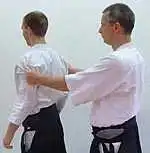 If the technique is done in jutai, starting before uke has completed the grab, then it's fairly easy. In gotai, from a static position, it can be significantly more difficult. This video clip shows gotai.
If the technique is done in jutai, starting before uke has completed the grab, then it's fairly easy. In gotai, from a static position, it can be significantly more difficult. This video clip shows gotai.Here it is important to get uke in motion. This is done by the first step, which is not straight forward, but to the side — to get out of uke's forward line of attack. While uke is still moving forward from the pull of your first step and your big arm movement, you sneak under uke's arm. Be quick to extend your arm to block uke from elbowing you or regaining control by just lowering the elbow. You also extend your arm to free yourself of uke's shoulder grip. Remember also to lift one shoulder, so that you easily get under uke's arm on that side, without having to bend your back. If you have to go even lower, to get under the arm, bend your knees and not your back. Katadori, the grip on just one of the shoulders, is not meaningful for uke in ushiro — unless it is combined with some other kind of attack, such as shomenuchi or kubishime. Therefore, only ryokatadori is shown here. If the attack is katadori, the one shoulder grip, ikkyo is done pretty much like on eridori.
Ushiro ryosodedori — omote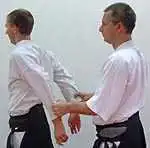 Sodedori, the grip on the sleeve, is usually done by the end of the sleeve. Gripping just one sleeve is of little meaning to uke, so this is mostly done ryosodedori, gripping both sleeves. Ikkyo is done very similarly to ryotedori, ryokatadori and ryohijidori.
Sodedori, the grip on the sleeve, is usually done by the end of the sleeve. Gripping just one sleeve is of little meaning to uke, so this is mostly done ryosodedori, gripping both sleeves. Ikkyo is done very similarly to ryotedori, ryokatadori and ryohijidori.Because the grip is in the keikogi and not the body, tori must make big movements to get uke to move from gotai, the static form. In jutai, the soft form where tori starts before the grip is completed, it's much easier. So, gotai is shown here. For your arm to make a good circle that gets uke moving, make sure to use your hand as well. Your accentuated hand form and movement of your hand helps a lot in making the initial move big and forceful. Duck under the other arm without losing your posture — bend your knees instead of your back. Also, make your other arm do an upward curve, so that you easily get under uke's arm. Don't worry about uke's grips on your sleeves. You will release both when you extend your arm to do the ikkyo move.
Just as with omote, uke's grips on your sleeves will be released when you extend your arm to do the ikkyo.
Ushiro ryohijidori — omote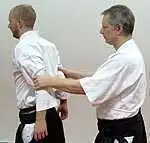 It's not easy for uke to hold on to a hijidori grip, on tori's elbow. The elbow is strong, and only a big hand can get around it for a good grip. That might be why this attack form is quite rare in aikido training. There is little meaning for uke applying it only on one elbow, so ryohijidori, grabbing both elbows, is used almost exclusively.
It's not easy for uke to hold on to a hijidori grip, on tori's elbow. The elbow is strong, and only a big hand can get around it for a good grip. That might be why this attack form is quite rare in aikido training. There is little meaning for uke applying it only on one elbow, so ryohijidori, grabbing both elbows, is used almost exclusively.Ikkyo is done very similarly to ryosodedori, ryokatadori and ryotedori. Make sure to extend the curves you make with your arms, so that you easily get uke in movement, and just as easily get under uke's arm without bending your back. The elbow grips are simple to release, by extending your arm for the ikkyo.
Kubishime — omote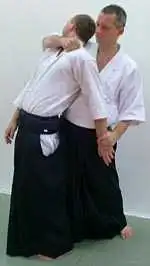 In aikido, the neck lock attack is done from behind, and not really a strangulation. The attacker just holds the defender by this, and adds a grip on one of the defender's wrists to avoid counter measures. Properly, it should be called something like ushiro katatedori kubishime.
In aikido, the neck lock attack is done from behind, and not really a strangulation. The attacker just holds the defender by this, and adds a grip on one of the defender's wrists to avoid counter measures. Properly, it should be called something like ushiro katatedori kubishime.In practicing this, the defender should make sure to turn the head to the side where the attacker's elbow is, in the neck lock, so as to avoid unpleasant pressure on the throat, and for men on the adam's apple. You start by getting the grip on your wrist to your front, in the same way as with ushiro ryotedori — twist your body to get your hand on the hip. Here you have to remain with your head in the fixed position, while your hip moves to fetch your hand. Immediately upon getting your hand on your front, you slide out of the neck lock by turning circularly in a direction away from the elbow. Don't turn in the direction of the elbow, or you'll only get more stuck in the lock. Away from the elbow, and in close contact with the attacker's body. If you try to lean forward, the neck lock just presses harder on your throat. Instead, lean back, almost pushing the attacker backward, and then make the turn away from the elbow. It's not that difficult, even if the arm lock on your neck is hard. Do it swiftly, to avoid the attacker increasing the pressure on your throat. At the same time as you sneak out of the neck lock, you get under the attacker's other arm, on which you do the ikkyo. You must step back to the side, out of the attacker's reach, or you will end up in a weakened position. As soon as you have passed under the attacker's arm, extend yours to hold it up and off, so that he or she cannot regain the lock, or another grip on you. The rest of the ikkyo is easily recognizable.
Ushiro eridori — omote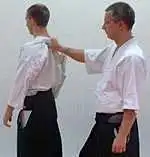 Eridori, the collar grip, is tricky because of uke's distance from tori, making it hard to get uke moving. Tori needs to get under uke's arm to do ikkyo, but that is risky if uke is in full balance. If uke is made to move forward, tori can sneak under uke's arm without much risk.
Eridori, the collar grip, is tricky because of uke's distance from tori, making it hard to get uke moving. Tori needs to get under uke's arm to do ikkyo, but that is risky if uke is in full balance. If uke is made to move forward, tori can sneak under uke's arm without much risk.When tori spins around to get uke moving, this is initiated by a taisabaki turn out of the line of uke's forward direction. That way, uke can be pushed forward, which is the direction uke is the least resistant against. It is necessary for tori to have good balance and a strong spirit forward, when ducking under uke's arm. Bend your knees instead of your back, when ducking under the arm, for maximum balance. The collar grip is released by tori pushing uke's arm upward for the ikkyo.
Kakaedori — omote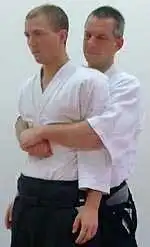 When it comes to kakaedori, the bear hug, in aikido it is normally made from behind. That would be ushiro kakaedori, whereas a bear hug from the front would be mae kakaedori. There are two more ways of doing it — around the arms or under the arms, whereof the former is mostly practiced in aikido.
When it comes to kakaedori, the bear hug, in aikido it is normally made from behind. That would be ushiro kakaedori, whereas a bear hug from the front would be mae kakaedori. There are two more ways of doing it — around the arms or under the arms, whereof the former is mostly practiced in aikido.There are different ways of getting free from the bear hug, where the arms are also held in the hug. The one I show and prefer, demands three things to happen at once, and very decisively: you exhale, you lower your body by bending your knees, and you extend your arms as much as you can, without bending them. This way, you will slip down, even if the attacker is hugging quite hard. It needs to be done as a surprise, though. Don't lean forward. Instead, stand straight or even allow yourself to lean a bit toward the attacker at your back. When you go down, it is straight down, and your extended arms should be in a streamline curve, with your hands turning in an outward curve. As you slip down, move your arms up — without bending them. You can see it on the video clip. You cannot stay in this position, or the attacker will renew his or her bear hug — this time around your neck. Sneak out with a movement to the side backward. As soon as you have passed under the attacker's arm, extend your arm to block it from coming down again. Put your one hand on his or her upper arm, and grab the wrist with your other hand. Now, you should be able to do the ikkyo omote, as usual.
Kakaedori — inner — omote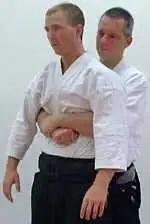 The other form of kakaedori is under the arms, grabbing only the body. This seems to be less of a problem to get out of, but that is not the case. The grip can be very strong, and there are few ways to open it. Also, in this bear hug, it's harder to halt it, if the attacker lifts you — or swings you backward, like in classical wrestling.
The other form of kakaedori is under the arms, grabbing only the body. This seems to be less of a problem to get out of, but that is not the case. The grip can be very strong, and there are few ways to open it. Also, in this bear hug, it's harder to halt it, if the attacker lifts you — or swings you backward, like in classical wrestling.You start by grabbing the attacker's outer hand, by the side of the little finger. Then you twist your upper body and make an atemi with your elbow toward the attacker's face, to make him or her dodge away from it. Immediately you turn your whole body to the other side, at the same time as you bend up the grip of the attacker's outer hand, and take it with you in your turn. You can see it on the video clip, if my words make little sense. Be quick to extend your other arm and block the attacker's elbow from coming down again. After that, you can do ikkyo omote as usual. What you see on the video clip is more of an ura, really, because there was a wall in the way of a proper omote. No big difference, actually. One has to adapt to circumstances.
Stefan Stenudd
IKKYO COMPLETE
AIKIDO PRACTICEIntroductionAikido Techniques — all the basic movesAttacks in Aikido
Tantodori — knife defenseAikiken — aikido sword techniquesJo 31 Kata in four directionsAikibatto sword and staff exercisesAiki — joining energiesKi exercisesAikido Video ClipsAikido PhotosMy aikido dojo in Malmö, SwedenMy aikido seminarsAIKIDO THEORYMy Aikido BioAikido GlossaryTanden, the CenterAikido InksAikido as Self-DefenseRunning a DojoAikido is TrueOsensei and EinsteinAikiWeb ColumnsAikido Books ReviewedDie deutsche Version meines Aikido-Buches onlineAikido på svenskaAbout CookiesMy Other WebsitesCREATION MYTHSMyths in general and myths of creation in particular.
TAOISMThe wisdom of Taoism and the Tao Te Ching, its ancient source.
LIFE ENERGYAn encyclopedia of life energy concepts around the world.
QI ENERGY EXERCISESQi (also spelled chi or ki) explained, with exercises to increase it.
I CHINGThe ancient Chinese system of divination and free online reading.
TAROTTarot card meanings in divination and a free online spread.
ASTROLOGYThe complete horoscope chart and how to read it.
MY AMAZON PAGE
MY YOUTUBE AIKIDO
MY YOUTUBE ART
MY FACEBOOK
MY INSTAGRAM
MY TWITTER
STENUDD PÅ SVENSKA
|
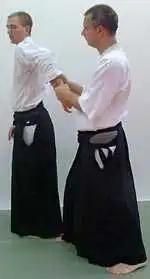 We start with an attack that is sort of half behind. The morotedori (also called katate ryotedori)is often done so that the attacker stands in front of the defender and occupies both of his or her hands by grabbing just one of the defender's arms. That is not very practical at all, leaving the attacker rather defenseless, while the defender has one arm free and the other person well within reach. Who would do that?
We start with an attack that is sort of half behind. The morotedori (also called katate ryotedori)is often done so that the attacker stands in front of the defender and occupies both of his or her hands by grabbing just one of the defender's arms. That is not very practical at all, leaving the attacker rather defenseless, while the defender has one arm free and the other person well within reach. Who would do that? Aikido Principles
Aikido Principles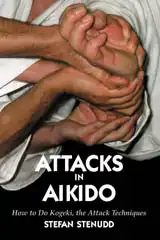 Attacks in Aikido
Attacks in Aikido Aikibatto
Aikibatto
